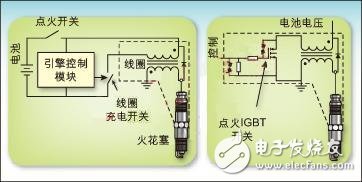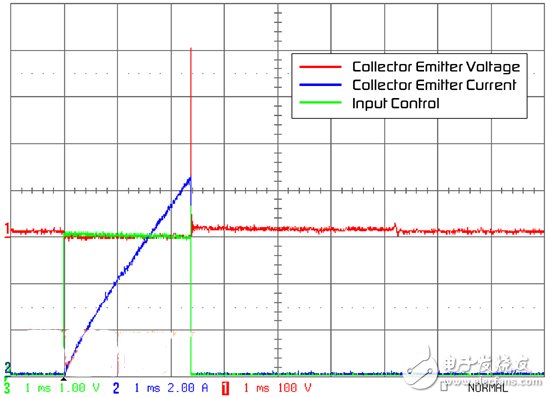In addition to diesel engines, all internal combustion engines have a basic circuit (automobile ignition system). Switching elements for ignition coil charging have undergone great evolution: from a single mechanical switch, multiple breaker contacts in a distributor, to high-voltage Darlington bipolar installed in a distributor or in a separate electronic control module The transistor is connected to an insulated gate bipolar transistor (IGBT) mounted directly on the ignition coil of the spark plug, and finally the smart IGBT directly mounted in the ignition coil of the spark plug.

Figure 1: Schematic diagram of the car ignition system
Advantages of IGBT
Many years ago, IGBTs have become switches in ignition applications. Figure 2 shows a cross-sectional view of the IGBT. Compared with other technologies, IGBT has the following important advantages:
1. The saturation pressure at high current is reduced;
2. It is easy to construct a circuit that can handle high voltage coils (400~600V);
3. Simplified MOS drive capability;
4. Can withstand high energy consumption (within SCIS rated range) when the coil is working abnormally.
The schematic diagram of the ignition IGBT shown in Figure 2 includes several additional important elements. The collector-to-gate avalanche diode stack establishes a "on" voltage. When the collector is forced to rise to this voltage by a flyback or spike from the coil, the IGBT will conduct, and the IGBT will consume its active area. The remaining energy accumulated in the coil (rather than using it to create a spark). With this avalanche "clamp" circuit, the IGBT can limit the clamping voltage to a much lower breakdown voltage than the N-type epitaxial doped/P-substrate (N epi/P base) semiconductor to ensure its safety. run. This significantly increases the ability of the ignition IGBT to withstand the energy of the self-clamping inductive switch (SCIS). This capacity is a rated indicator, that is, the energy absorbed by the IGBT each time the energy in the ignition coil is released as a spark. By limiting the voltage on the primary coil, the ignition coil itself is also over-voltage protected.

Figure 2: IGBT profile
The latest generation of IGBTs has been able to significantly reduce the die area in IGBTs while still maintaining excellent SCIS capability. This advancement is spawning multi-die smart IGBT products. These smart products combine high-performance BCD IC technology with high-performance power discrete component IGBTs. The demand for the intelligent IGBT coil drive circuit is that the development direction of the power switch is changed from an external engine control module to a component directly in the ignition coil on the spark plug in the engine. When the ignition coil is located on the spark plug, this structure is called "coil on plug"; when the coil drive circuit is included in the coil, this structure is called "switch on coil".
The "switch on coil" structure offers significant advantages in terms of system performance, reliability and cost. Some of its advantages are as follows:
1. No high voltage spark plug wire is required;
2. No heat is generated in the engine control module;
3. Save space in the engine control module;
4. Improves engine control by monitoring actual spark generation.
The last performance advantage has spurred demand for smart IGBTs. As a result, automotive ignition switch functions are evolving into smart devices that monitor spark conditions, take current limiting measures to protect the coil, and pass the engine's ignition status to the engine control system.
Ideal smart IGBT function in "switch on coil" application
1. Signal interface of the engine control module
There are many problems with the "on-coil switch" smart IGBT driven by the engine control module. The electrical environment noise under the hood is very disturbing. The signal interface of the engine control module not only needs to cope with these noises, but also solves the potential problem of several meters of connection between the engine control module and the coil position. Electrical noise can come from EMI radiated signal noise or magnetic induced noise caused by large currents in adjacent lines.
In addition to the above noise problems, there is a voltage difference of several volts between the actual ground reference point of the engine control module and the ground point at which the coil or engine is located. Therefore, the defined interface between the engine control module and the intelligent ignition coil drive circuit must be able to cope with these problems.
2. Protect the ignition coil
The input signal in Figure 3 commands the IGBT to begin charging the ignition coil. Under normal conditions, the current will reach 7~10A when the coil stops charging and releases sparks. However, when the engine is at a low speed, especially during an emergency deceleration or engine control time, if the input is not cut, the IGBT will cause the coil charging current to exceed the rated value, which may cause damage to the coil winding.

Figure 3: Typical ignition waveform
Smart IGBTs have been designed with several circuits to prevent ignition coils from being damaged in this situation.
The first is a current limiting circuit that directly measures the IGBT collector current with a sense resistor or with a current sense IGBT. Figure 4 shows these two circuits.

Figure 4: Current limiting circuit
Starlight SA series (O. 4Ah~28Ah) Vrla Batteries are designed with AGM (Absorbent Glass Mat) technology and for general application purposes, such as UPS, telecom, and electrical utilities. With 10 years design life, the batteries comply with the most popular international standards, such as lEC60896-21, BS6290-4, Europe Guide.
Stable Quality& High Reliability
Our battery is well-known for its stable and reliable performance. Our batteries are easy to maintain; thus, permitting a safe and proper operation of the equipment that the battery powers. The battery can withstand overcharge, over-discharge, vibration, and shock. It is also capable of extended storage.
Sealed Construction
Our unique construction and sealing technique guarantee that no electrolyte leakage can occur from the terminals or case of any of our batteries. This feature ensures the safe and efficient operation of our batteries in a position. Our batteries are classified as "Non-spillable" and will meet all requirements of the International Air Transport Association.
Long Service Life, Float or Cyclic
Our SA series Vrla Battery has a long life in float or cyclic service. Designed Life: 10 years.
Maintenance-free Operation
During the expected float service life of our batteries, there is no need to check the specific gravity of the electrolyte or add water. In fact, there is no provision for these maintenance functions.
Small Sized VRLA Battery, Rechargeable Storage Batteries,UPS Battery, Solar Battery
Starlight Power Industrial Company Limited , https://www.starlite-power.com